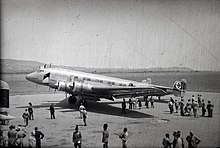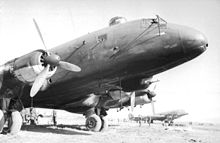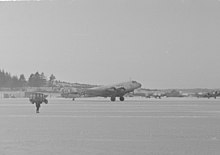Junkers Ju 90
| Ju 90 | |
|---|---|

| |
| Ju 90 V1Der Grosse Dessauer withDaimler-Benz DB 600C motors, 1937 | |
| Role | Airliner,transport |
| National origin | Germany |
| Manufacturer | Junkers |
| First flight | 28 August 1937 |
| Introduction | 1938 |
| Primary users | Deutsche Luft Hansa Luftwaffe |
| Number built | 18 |
| Developed from | Junkers Ju 89 |
| Developed into | Junkers Ju 290 |
TheJunkers Ju 90was a 40-seat, four-engineairlinerdeveloped for and used byDeutsche Luft Hansashortly beforeWorld War II.It was based on the rejectedJu 89bomber.During the war, theLuftwaffepressed them into service as military transports.
Design and development
[edit]The Junkers Ju 90 airliner andtransportseries descended directly from the Junkers Ju 89, a contender in theUral bomberprogramme aimed at producing a long-rangestrategic bomber.This concept was abandoned by theReichsluftfahrtministerium(RLM, Reich Aviation Ministry) in April 1937 in favour of smaller, faster bombers. Design was headed by Ernst Zindel.[1]Development was headed by Professor Herbert Wagner.[2]
Civil development
[edit]Deutsche Luft Hansaput a request for a long-distance commercial aircraft as early as 1933. When the Ju 89 program was abandoned, the thirdprototypewas partially completed and at the request of Luft Hansa, it was rebuilt as an airliner, retaining the wings and tail of the original design, but incorporating a new, wider, passenger-carryingfuselage.The new design was designated the Ju 90.[3][4][5]
The Junkers Ju 90[3][6][7]was a four-engine all-metal, low-wing aircraft fitted with twin end-platevertical stabilizers.The wings were built around five tubular girdersparscovered with a smoothstressed skin.Theleading edgewas quite markedlyswept,thetrailing edgealmost straight. The Junkers "double wing", a full-span movableflap/aileroncombination, was fitted. The tail units on the prototypes used the traditional Junkers corrugated skin, the only part of the aircraft to do so, abandoning the exposed corrugated skinning on later Ju 90 production models for the Luftwaffe. The fins andrudders,the latter with prominent horn balances assemblies, were placed at the end of thetailplane;this latter carried theelevatorsseparated by a gap, forming another double wing. These components were as used in the Ju 89.

The new fuselage was of oval cross-section, covered by stressed smoothduraluminskin. On the first four Ju 90As, five pairs of rectangular windows were on each side, each double pair lighting a divided-off section of thecabincontaining eight seats in facing pairs on either side of a central aisle. The Ju 90B, whose prototypes were the Ju 90 V5 through the Ju 90 V10 aircraft, adopted round fuselage portholes. The Ju 90 V11 became the definitiveJu 290prototype with smaller, rectangular fuselage windows.
TheJu 90Bseries were visually distinctive because of their oval tail fins. The Ju 90 V6 was withdrawn from test flights, and rebuilt as theJu 390 V1prototype. The Ju 90 V9 was also withdrawn and rebuilt as the Ju 390V2, later redesignated in October 1944 as the Ju 390A-1. The Ju 90 V10's rebuild into the Ju 390 V3 bomber prototype was commenced, but was scrapped at the factory in June 1944. The Junkers firm was paid compensation for seven Ju 390s under construction, when Ju 390 orders were cancelled.
The plane had four or five divided fuselage sections, the latter holding the maximum of 40 passengers. Toilets, a cloakroom and a mail store were placed aft, and a baggage hold was forward of the passenger space. The fuselage was generous by the standards of the time with an internal width of 2.83 m (9 ft3+1⁄2in).
Thetailwheel undercarriagewas fully retractable, with the single-wheel main units raising hydraulically into the inner engine nacelles.
The first prototype, the Ju 90 V1, was powered by fourDaimler-Benz DB 600C liquid-cooled invertedV enginesdelivering 820 kW (1,100 hp) each. These were more powerful than both those of its Ju 89 predecessor and of production commercial Ju 90s. NamedDer Grosse Dessaueras had been the earlierJunkers G 38,its maiden flight took place on 28 August 1937. Deutsche Luft Hansa carried out the long-distance testing. After eight months of flight tests, this prototype broke up on 6 February 1938 during over-speed tests.[3]

A second prototype (V2) was delivered to Luft Hansa in May1938for testing. Like all the production commercial Ju 90s, this was powered by fourBMW 132radial enginesdelivering 620 kW (830 hp). The move to lower power was probably necessitated by the demands on Daimler Benz to produce engines for strategically important front-line aircraft.[5]They named this aircraftPreussen.It crashed fatally during tropical flight tests on takeoff in November 1938 at Bathurst,Gambia,probably because of engine failure.
Despite these setbacks, Luft Hansa ordered eight of the production type A-1s. They also used the next two prototypes, starting with V3Bayernwhich flew on the Berlin-Vienna route from July 1938. This aircraft flew a total of 62,572 km ( mi) in 1938.[5]Only seven of the A-1s were delivered to Luft Hansa, the last in April 1940, one going directly to the Luftwaffe.[7]
South African Airwaysalso ordered two A-1s withPratt & Whitney Twin Waspengines delivering 670 kW (900 hp). These were known by the alternative designationZ-3to distinguish them from the BMW-powered Z-2. Neither of these was delivered to SAA, but went instead to the Luftwaffe. As the war progressed, the surviving six Luft Hansa airframes were also impressed into Luftwaffe service, though two were returned to Luft Hansa later. Four of these aircraft took part in theinvasion of Norway.[8]
The fourth prototype V4 went into Luftwaffe service in July 1941 fitted with 980 kW (1,320 hp)Jumo 211F/L engines.
Military development
[edit]
In April 1939, the RLM asked Junkers for a further development of the Ju 90 for military transport purposes.[3][7]The Ju 90V5 and V6 were the prototypes of this military design. They got a new wing with a straight inner section leading edge, of greater span (19%) and area (11%). The landing gear was strengthened with twin main wheels and the fins were more rounded, lacking the characteristic horn balance nick of the earlier models. The windows were replaced by 10 small portholes a side. The Ju 90 V5 flew first on 5 December 1939. A special feature of both the V5 and V6 was a powered boarding ramp in the floor of the rear section of the fuselage for loading cars and larger cargo freight.[7][9]ThisTrapoklapperamp, when lowered, was powerful enough to raise the fuselage to the horizontal flying position. Both aircraft were retroactively fitted with the much more powerful,unitizedKraftei-mount 1,200 kW (1,600 hp)BMW 801MA radials, with the first suffix letter "M" signifying the initialMotoranlageformat of unitized powerplant installation design promulgated by theRLM.Ju 90s were also used as tugs for heavy gliders.

The two last prototypes – the V7 and V8 – fed directly into the Ju 290 development programme. The former had a fuselage extension of 1.98 m (6 ft 6 in) and the addition ofdihedralto the tailplane to solve a yaw instability. A reconnaissance prototype aerodynamically similar to the V7, the V8 was armed, however, with two 20 mmMG 151/20 cannonsand up to nine 13 mm (.51 in)MG 131 machine gunsin two dorsal, one ventral, and one tail position.
Ju 290 / 390 development
[edit]Some of the Ju 90s were converted into prototypes of the biggerJu 290transport and reconnaissance aircraft. The more powerful engines and other modifications to the Ju 90 V5 and V7 were steps in this direction and the latter was converted into the Ju 290 V3. The Ju 90 V8 became the second prototype Ju 290 V2.[10]An uncompleted 11th A-series machine was turned into the Ju 290 V1.[7]The Ju 90 V6 airframe was used in the construction of the Junkers Ju 390 V1.
Numbers and survivors
[edit]In the end, only 18 Ju 90s of all versions were completed. Just two survived the war to fall into Allied hands, but both were scrapped soon afterwards.[3][4] A military transport JU 90 was shot down on July 23, 1943, south of Bastia, North Corsica. The wreck is easily accessible to scuba divers and 70% complete[11]
Operators
[edit]Accidents and incidents
[edit]- 26 November 1938:aDeutsche Luft HansaJu 90V2, registration D-AIVI, namedPreussen,crashed on takeoff at Bathurst (nowBanjul), Gambia, while on a test flight due to double engine failure, killing 12 of the 15 people on board.
- 8 November 1940:a Deutsche Luft Hansa Ju 90A, registration D-AVMF, namedBrandenburg,crashed in icing conditionsatSchönteichen,Germany, killing all 29 on board.
- 9 August 1944:a Deutsche Luft Hansa Ju 90V3, registration D-AURE, namedBayern,was destroyed on the ground atStuttgart Airportduring an air raid; there was no one on board.
Specifications (Ju 90A-1)
[edit]
Data fromJunkers aircraft and engines, 1913–1945,[7]German aircraft of the Second World War[12]
General characteristics
- Crew:4
- Capacity:38–40 passengers
- Length:26.3 m (86 ft 3 in)
- Wingspan:35.02 m (114 ft 11 in)
- Height:7.5 m (24 ft 7 in)
- Wing area:184 m2(1,980 sq ft)
- Empty weight:19,225 kg (42,384 lb)
- Gross weight:33,680 kg (74,252 lb)
- Powerplant:4 ×BMW 132 H-19-cylinder air-cooled radial piston engine, 610 kW (820 hp) each
- Propellers:3-bladed constant-speed propellers
Performance
- Maximum speed:350 km/h (220 mph, 190 kn) at 2,500 m (8,200 ft)
- Cruise speed:320 km/h (200 mph, 170 kn) at 3,000 m (9,800 ft)
- Landing speed:109 km/h (68 mph; 59 kn)
- Range:1,247 km (775 mi, 673 nmi)
- Ferry range:2,092 km (1,300 mi, 1,130 nmi)
- Service ceiling:5,750 m (18,860 ft)
See also
[edit]Related development
Aircraft of comparable role, configuration, and era
Related lists
References
[edit]- ^Zoeller, Horst."Junkers – Who is Who? E".The Hugo Junkers Homepage. Archived from the original on 27 October 2009.Retrieved22 June2016.
{{cite web}}:CS1 maint: unfit URL (link) - ^Zoeller, Horst."Junkers Ju90 / Ju290 / Ju390".The Hugo Junkers Homepage. Archived fromthe originalon 1 April 2020.Retrieved22 June2016.
- ^abcdeTurner, P. St.J. and Nowarra, H.Junkers: an aircraft album no.3.(1971) New York: Arco Publishing IncISBN978-0-668-02506-5
- ^ab"Junkers Ju90".hugojunkers.bplaced.net.Retrieved11 March2023.
- ^abc"Airbus Group – Airbus Group".Archived fromthe originalon 9 January 2009.Retrieved28 August2008.
- ^Bridgeman, L.Jane's All the World's Aircraft.(1942) London: Sampson, Low, Marston & Co. Ltd.
- ^abcdefKay, Anthony L. (2004).Junkers aircraft and engines, 1913–1945(1st ed.). London: Putnam Aeronautical Books. pp. 190–197.ISBN0851779859.
- ^Junkers Ju90 Production List(Serials)
- ^Turner, P. St.J. and Nowarra, H. Ju 290 section
- ^"Golden Years home".
- ^"Epave du Junker 90 de l'IGESA - Bastia - EPAVE CORSE - Décembre 2016".30 December 2016.Retrieved11 March2023– via youtube.
- ^Smith, J.R.; Kay, Anthony L. (1990).German aircraft of the Second World War(7th impression ed.). London: Putnam. pp. 418–422.ISBN0851778364.
Further reading
[edit]- Zuerl, Walter (1941).Deutsche Flugzeug Konstrukteure.München, Germany: Curt Pechstein Verlag.
External links
[edit]- Four Miles a Minute Sky Sleeper Sleeps Forty,January 1938, Popular Mechanicsarticle with rare photos of JU-90V1 version and interior photos
- WW2 in Color[permanent dead link]very good information on the JU-90 history
